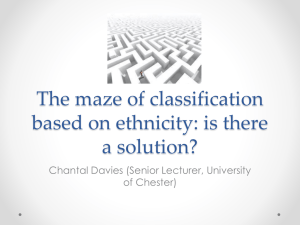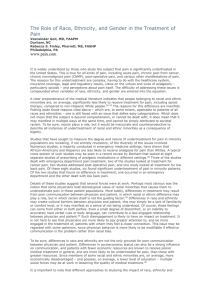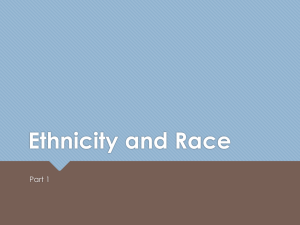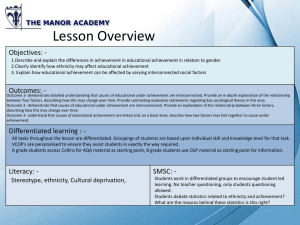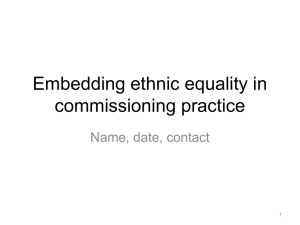Race and Ethnicity in American Life
advertisement
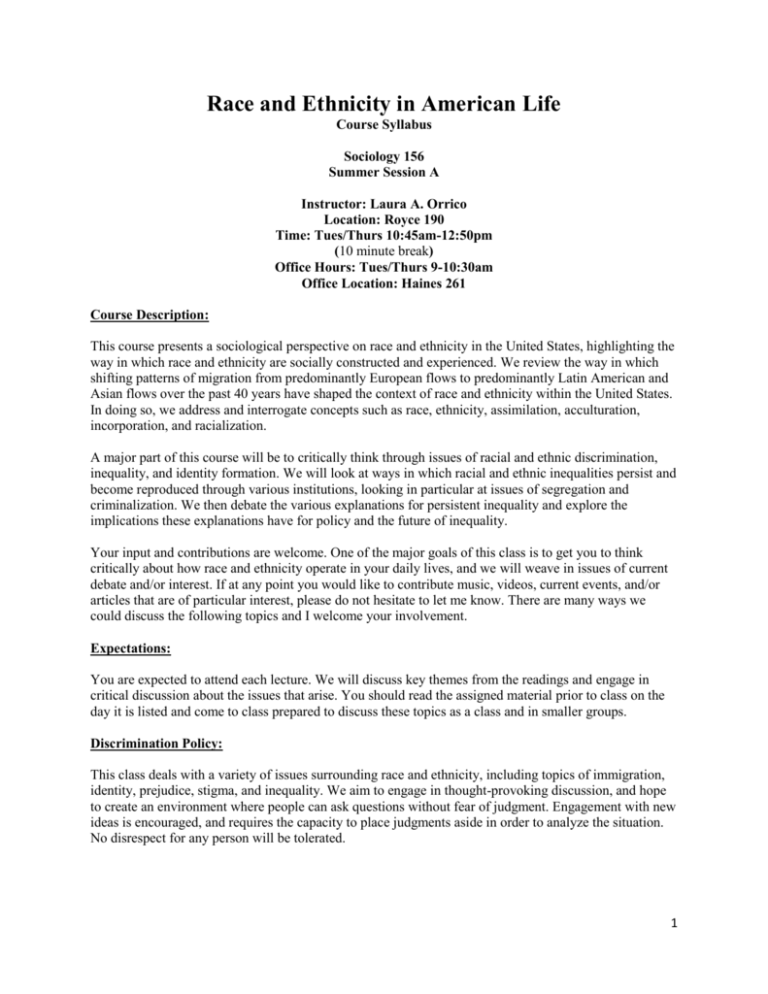
Race and Ethnicity in American Life Course Syllabus Sociology 156 Summer Session A Instructor: Laura A. Orrico Location: Royce 190 Time: Tues/Thurs 10:45am-12:50pm (10 minute break) Office Hours: Tues/Thurs 9-10:30am Office Location: Haines 261 Course Description: This course presents a sociological perspective on race and ethnicity in the United States, highlighting the way in which race and ethnicity are socially constructed and experienced. We review the way in which shifting patterns of migration from predominantly European flows to predominantly Latin American and Asian flows over the past 40 years have shaped the context of race and ethnicity within the United States. In doing so, we address and interrogate concepts such as race, ethnicity, assimilation, acculturation, incorporation, and racialization. A major part of this course will be to critically think through issues of racial and ethnic discrimination, inequality, and identity formation. We will look at ways in which racial and ethnic inequalities persist and become reproduced through various institutions, looking in particular at issues of segregation and criminalization. We then debate the various explanations for persistent inequality and explore the implications these explanations have for policy and the future of inequality. Your input and contributions are welcome. One of the major goals of this class is to get you to think critically about how race and ethnicity operate in your daily lives, and we will weave in issues of current debate and/or interest. If at any point you would like to contribute music, videos, current events, and/or articles that are of particular interest, please do not hesitate to let me know. There are many ways we could discuss the following topics and I welcome your involvement. Expectations: You are expected to attend each lecture. We will discuss key themes from the readings and engage in critical discussion about the issues that arise. You should read the assigned material prior to class on the day it is listed and come to class prepared to discuss these topics as a class and in smaller groups. Discrimination Policy: This class deals with a variety of issues surrounding race and ethnicity, including topics of immigration, identity, prejudice, stigma, and inequality. We aim to engage in thought-provoking discussion, and hope to create an environment where people can ask questions without fear of judgment. Engagement with new ideas is encouraged, and requires the capacity to place judgments aside in order to analyze the situation. No disrespect for any person will be tolerated. 1 Grading: The requirements for this class have been broken into smaller assignments. The idea is to remain engaged throughout the session, to offer multiple ways to gain points, and to avoid a major ‘crunch’ at the middle and end. Regular attendance, participation, and completion of the reading should provide enough tools for success in this course. Attendance: Attendance is mandatory for all sections and participation, both individual and during group work, will be considered in your final score. Participation and Discussion: Throughout the course we will utilize group discussion to think through some of the course material and how the material relates to the experience of race and ethnicity in the US. At times, you may be required to share your thoughts, as a group or individually, or to produce a brief written response or analysis. These will not be graded, as they are designed to get you involved, thinking, and talking about the course material. However, they will be used as a part of your participation score. If you are absent during such activities, you forfeit the points. 10 pts = 10% Short Responses: You will be responsible for two short responses (2 pgs) to the assigned reading of your choice, due on the day that reading is assigned. Each will include a brief summary of the major arguments/points presented in the reading followed by your personal response to the discussion. This may include a critique of, and/or support for, the arguments presented. You may relate the reading to ongoing class discussions and you may choose to compare the perspectives of two readings where appropriate. 5 pts each = 10% Quiz: There will be one multiple choice quiz to assess your comprehension of the major concepts covered in the class. 20 pts = 20% (July 10, 2014) Interview Assignment (3-5pgs): You will perform one long interview (1-hr.) or compare three shorter interviews (20 mins.) to explore some aspect of race and ethnicity as it is experienced. This can include a range of topics like immigration, discrimination, identity, etc. You should incorporate at least 3 sources from the course material to write a thoughtful discussion about the individual experience in relation to the concepts we have been discussing in class. 20 pts = 20% (Due on July 15, 2014) News/Media Assignment (5pgs): You may choose any issue that you believe to be about race and/or ethnicity in the U.S., either explicitly or implicitly. I want you to survey the media coverage of the issue (at least 5 major sources) to critically assess the reports in light of the course material and major concepts we have been discussing. Do the reporters make explicit reference to race and/or ethnicity? If not, how does the coverage reproduce or challenge racial and ethnic constructs and meanings? Think about whose perspective the report originates from and what the reporter and publication may assume about their audience. For instance, does a story about immigration originate from an assumption that assimilation is positive and possible? Does coverage of affirmative action originate from an assumption that we are living in a ‘post-racial’ society? As you relate the news coverage to the course material, you are required to use at least 4 sources from the course reading. These sources should provide a foundation from which to build your argument and you should build from the major concepts presented in the material. In order to incorporate the material, you may or may not include a quotation. Keep in mind, merely including a quotation is not the same as showing me how you are building from the ideas, results, and/or concepts presented. 40 pts = 40% (Due on July 31, 2014) *All writing assignments must be done in the following format: Title Page, Times New Roman, 12 pt. font, double-spaced, 1-inch margins, page numbers, references. 2 Weekly Discussion and Required Readings: *Readings will be posted on the course website, but I expect you to print the material and bring it to class. You are required complete the reading prior to class on the day it is listed. Week I. Introduction, concepts, context 6/24 Introduction & Video, Race: The Power of an Illusion (NO READING DUE) 6/ 26 The Social Construction of Race 1. Omi and Winant, Racial Formation in the United States, pgs. 48-76 2. Stephen Cornell and Douglas Hartmann. 2007. Ethnicity and Race: Making Identities in a Changing World pgs 15-39 Questions to Consider: Is race biological? What does it mean to say race is a social construction? What are the main differences between race and ethnicity? How are these experienced? discussed? constructed? Week II. Immigration in the US Context: History & Concepts 7/1 Immigration – Historical Context & Theories 1. Kasinitz, “Race, Assimilation, and ‘Second Generations,’ Past and Present” pgs. 279298. In Foner and Fredrickson (ed.) Not Just Black and White. 2. Tomás R. Jiménez, “Mexican Immigrant Replenishment and the Continuing Significance of Ethnicity and Race,” American Journal of Sociology 7/3 Immigration - Race, Ethnicity, and Belonging 1. Mary Waters, Ethnic Options 2. Zhou, “Are Asian American becoming white?” Contexts. Questions to Consider: How has immigration changed and what are the major differences? What is assimilation and is this still a useful concept? Where do we still see models of assimilation promoted? How do immigration, race, and ethnicity become intertwined with notions of citizenship and belonging? Week III. Race, Ethnicity, and Identity 7/8 Racial and Ethnic Identities in a Changing Context 1. Clara E. Rodriquez, Ch. 1, Changing Race 2. Ocampo, “Are second-generation Filipinos ‘becoming’ Asian American or Latino? Historical colonialism, culture and panethnicity.” Ethnic and Racial Studies. 7/10 Intersections - Gender & Class 1. Amy Wilkins. 2004. “Puerto Rican Wannabees: Sexual Spectacle and the Marking of Race, Class, and Gender Boundaries.” Gender and Society. 2. Ojita, “Growing up, Growing Apart,” How Race is Lived in America *Quiz Questions to Consider: How do racial and ethnic identities emerge and change? What are pan ethnic identities? What role does identity play? How do people live and experience race and ethnicity? What do these experiences tell us? 3 Week IV. Making Race ‘Real’ in America 7/15 Segregation and its Effects 1. Massey, Rothwell, Domina. 2009. “The Changing Bases of Segregation in the US” The ANNALS of the American Academy of Political and Social Science 2.Vigil, Community Dynamics and the Rise of Street Gangs, In Suárez-Orozco and Páez (eds), Latinos. *Interview Assignment Due 7/17 Criminalization & Policing 1. Nils Christie Crime Control as Industry Ch 7 “USA – the Trend-setter” pgs. 91-110 2. Victor Rios. 2011. “The Labeling Hype: Coming of Age in the Era of Mass Incarceration” (Ch. 3) in Punished: Policing the Lives of Black and Latino Boys, NYU Press. Questions to Consider: How do institutions produce and reproduce inequality? What are the long-term effects of segregation? What are the long-term effects of criminalization? Think again about how these processes intersect with issues of class and gender? Week V. Explanations of Inequality & their Implications 7/22 Explaining Inequality 1. William Julius Wilson, “More than Just Race” 2. Bonilla-Silva, Ch 4 “The New Racism” 7/24 Whiteness & Colorblind Racism 1. Bonilla-Silva, Ch 5 “The New Racism” 2. Lipsitz, “Possessive Investment in Whiteness” Questions to Consider: How do explanations of inequality differ? Do the ideologies behind explanations differ? What does it matter how we explain inequality? What are the implications for policy? Week VII. Representations & Context 7/29 Race & Ethnicity in Popular Culture 1. Kim and Chung. 2005. “Consuming Orientalism: Images of Asian/American Women in Multicultural Advertising.” Qualitative Sociology. 2. Avila-Saavedra. “Ethnic Otherness Versus Cultural Assimilation: U.S. Latino Comedians and the Politics of Identity.” 3. Ejima Baker. Can BET Make You Black? Remixing and Reshaping Latin@s on Black Entertainment Television. In Afro-Latino Reader. 7/31 Comparative contexts and the experience of moving to the U.S. Racial Structure 1. Telles. Race in another America. 2. Best of Friends, Worlds Apart – How Race is Lived in America * Media Assignment Due Questions to Consider: What is the role of media and popular culture in representing/constructing/challenging the meaning of race and ethnicity in the US? How are race and ethnicity contextual? How do people ‘come to see’ race differently? 4

